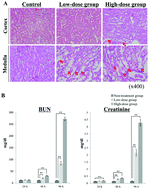当前位置:
X-MOL 学术
›
Toxicol. Res.
›
论文详情
Our official English website, www.x-mol.net, welcomes your feedback! (Note: you will need to create a separate account there.)
Metabolomics for the early detection of cisplatin-induced nephrotoxicity
Toxicology Research ( IF 2.1 ) Pub Date : 2017-08-29 00:00:00 , DOI: 10.1039/c7tx00171a Takeshi Ezaki 1, 2, 3, 4 , Shin Nishiumi 1, 2, 3, 4 , Takeshi Azuma 1, 2, 3, 4 , Masaru Yoshida 1, 2, 3, 4, 5
Toxicology Research ( IF 2.1 ) Pub Date : 2017-08-29 00:00:00 , DOI: 10.1039/c7tx00171a Takeshi Ezaki 1, 2, 3, 4 , Shin Nishiumi 1, 2, 3, 4 , Takeshi Azuma 1, 2, 3, 4 , Masaru Yoshida 1, 2, 3, 4, 5
Affiliation

|
Cisplatin, which is an inorganic molecule containing a platinum ion, is an antineoplastic agent that has been used to treat various solid tumors. However, its side effects include nephrotoxicity, neurotoxicity, bone marrow toxicity, gastrointestinal toxicity, and ototoxicity, which can limit its use. In this study, nephrotoxicity was caused by the intraperitoneal injection of cisplatin into rats, and then metabolome analysis was performed using gas chromatography/mass spectrometry (GC/MS) and liquid chromatography/mass spectrometry (LC/MS) to find plasma metabolite biomarker candidates that would facilitate the early detection of cisplatin-induced nephrotoxicity. As a result, chronological changes were detected in the plasma levels of cysteine–cystine and 3-hydroxy-butyrate in the GC/MS-based metabolomics study. In the LC/MS-based metabolomics study, 3 acylcarnitines and a phosphatidylethanolamine with C18:2–C18:2 were identified as potential plasma biomarkers of cisplatin-induced nephrotoxicity. The plasma levels of these 6 metabolites altered significantly after the administration of cisplatin, and these alterations occurred quicker than the equivalent changes in the plasma levels of creatinine and blood urea nitrogen, which are usually used as indicators of renal dysfunction. These results indicate that the abovementioned metabolites might be reliable biomarkers that would allow the earlier detection of cisplatin-induced nephrotoxicity and that metabolomics is a useful tool for discovering biomarkers that could be used to predict the side effects of cancer therapy.
中文翻译:

代谢组学用于顺铂诱导的肾毒性的早期检测
顺铂是一种含有铂离子的无机分子,是一种抗肿瘤药,已被用于治疗各种实体瘤。但是,其副作用包括肾毒性,神经毒性,骨髓毒性,胃肠道毒性和耳毒性,这可能会限制其使用。在这项研究中,肾毒性是由大鼠腹腔内注射顺铂引起的,然后使用气相色谱/质谱(GC / MS)和液相色谱/质谱(LC / MS)进行代谢组分析,以寻找血浆代谢物生物标志物这将有助于及早发现顺铂引起的肾毒性。结果,在基于GC / MS的代谢组学研究中,检测到血浆中半胱氨酸-胱氨酸和3-羟基丁酸酯的时间变化。在基于LC / MS的代谢组学研究中,鉴定出3种酰基肉碱和C18:2-C18:2的磷脂酰乙醇胺是顺铂诱导的肾毒性的潜在血浆生物标志物。服用顺铂后,这6种代谢物的血浆水平发生了显着变化,并且这些变化发生的速度比肌酐和血液尿素氮的血浆水平的等效变化快,后者通常被用作肾功能不全的指标。这些结果表明,上述代谢物可能是可靠的生物标志物,可以更早地检测出顺铂诱导的肾毒性,并且代谢组学是发现可用于预测癌症治疗副作用的生物标志物的有用工具。2个被确定为顺铂诱导的肾毒性的潜在血浆生物标志物。服用顺铂后,这6种代谢物的血浆水平发生了显着变化,并且这些变化发生的速度比肌酐和血液尿素氮的血浆水平的等效变化快,后者通常被用作肾功能不全的指标。这些结果表明,上述代谢物可能是可靠的生物标志物,可以更早地检测出顺铂诱导的肾毒性,并且代谢组学是发现可用于预测癌症治疗副作用的生物标志物的有用工具。2个被确定为顺铂诱导的肾毒性的潜在血浆生物标志物。服用顺铂后,这6种代谢物的血浆水平发生了显着变化,并且这些变化发生的速度比肌酐和血液尿素氮的血浆水平的等效变化快,后者通常被用作肾功能不全的指标。这些结果表明,上述代谢物可能是可靠的生物标志物,可以更早地检测出顺铂诱导的肾毒性,并且代谢组学是发现可用于预测癌症治疗副作用的生物标志物的有用工具。这些变化发生的速度比血浆肌酐和血液尿素氮的等效变化快,而血浆肌酐和血液尿素氮的变化通常被用作肾功能不全的指标。这些结果表明,上述代谢物可能是可靠的生物标志物,可以更早地检测出顺铂诱导的肾毒性,并且代谢组学是发现可用于预测癌症治疗副作用的生物标志物的有用工具。这些变化发生的速度比血浆肌酐和血液尿素氮的等效变化快,而血浆肌酐和血液尿素氮的变化通常被用作肾功能不全的指标。这些结果表明,上述代谢物可能是可靠的生物标志物,可以更早地检测出顺铂诱导的肾毒性,并且代谢组学是发现可用于预测癌症治疗副作用的生物标志物的有用工具。
更新日期:2017-08-29
中文翻译:

代谢组学用于顺铂诱导的肾毒性的早期检测
顺铂是一种含有铂离子的无机分子,是一种抗肿瘤药,已被用于治疗各种实体瘤。但是,其副作用包括肾毒性,神经毒性,骨髓毒性,胃肠道毒性和耳毒性,这可能会限制其使用。在这项研究中,肾毒性是由大鼠腹腔内注射顺铂引起的,然后使用气相色谱/质谱(GC / MS)和液相色谱/质谱(LC / MS)进行代谢组分析,以寻找血浆代谢物生物标志物这将有助于及早发现顺铂引起的肾毒性。结果,在基于GC / MS的代谢组学研究中,检测到血浆中半胱氨酸-胱氨酸和3-羟基丁酸酯的时间变化。在基于LC / MS的代谢组学研究中,鉴定出3种酰基肉碱和C18:2-C18:2的磷脂酰乙醇胺是顺铂诱导的肾毒性的潜在血浆生物标志物。服用顺铂后,这6种代谢物的血浆水平发生了显着变化,并且这些变化发生的速度比肌酐和血液尿素氮的血浆水平的等效变化快,后者通常被用作肾功能不全的指标。这些结果表明,上述代谢物可能是可靠的生物标志物,可以更早地检测出顺铂诱导的肾毒性,并且代谢组学是发现可用于预测癌症治疗副作用的生物标志物的有用工具。2个被确定为顺铂诱导的肾毒性的潜在血浆生物标志物。服用顺铂后,这6种代谢物的血浆水平发生了显着变化,并且这些变化发生的速度比肌酐和血液尿素氮的血浆水平的等效变化快,后者通常被用作肾功能不全的指标。这些结果表明,上述代谢物可能是可靠的生物标志物,可以更早地检测出顺铂诱导的肾毒性,并且代谢组学是发现可用于预测癌症治疗副作用的生物标志物的有用工具。2个被确定为顺铂诱导的肾毒性的潜在血浆生物标志物。服用顺铂后,这6种代谢物的血浆水平发生了显着变化,并且这些变化发生的速度比肌酐和血液尿素氮的血浆水平的等效变化快,后者通常被用作肾功能不全的指标。这些结果表明,上述代谢物可能是可靠的生物标志物,可以更早地检测出顺铂诱导的肾毒性,并且代谢组学是发现可用于预测癌症治疗副作用的生物标志物的有用工具。这些变化发生的速度比血浆肌酐和血液尿素氮的等效变化快,而血浆肌酐和血液尿素氮的变化通常被用作肾功能不全的指标。这些结果表明,上述代谢物可能是可靠的生物标志物,可以更早地检测出顺铂诱导的肾毒性,并且代谢组学是发现可用于预测癌症治疗副作用的生物标志物的有用工具。这些变化发生的速度比血浆肌酐和血液尿素氮的等效变化快,而血浆肌酐和血液尿素氮的变化通常被用作肾功能不全的指标。这些结果表明,上述代谢物可能是可靠的生物标志物,可以更早地检测出顺铂诱导的肾毒性,并且代谢组学是发现可用于预测癌症治疗副作用的生物标志物的有用工具。



























 京公网安备 11010802027423号
京公网安备 11010802027423号